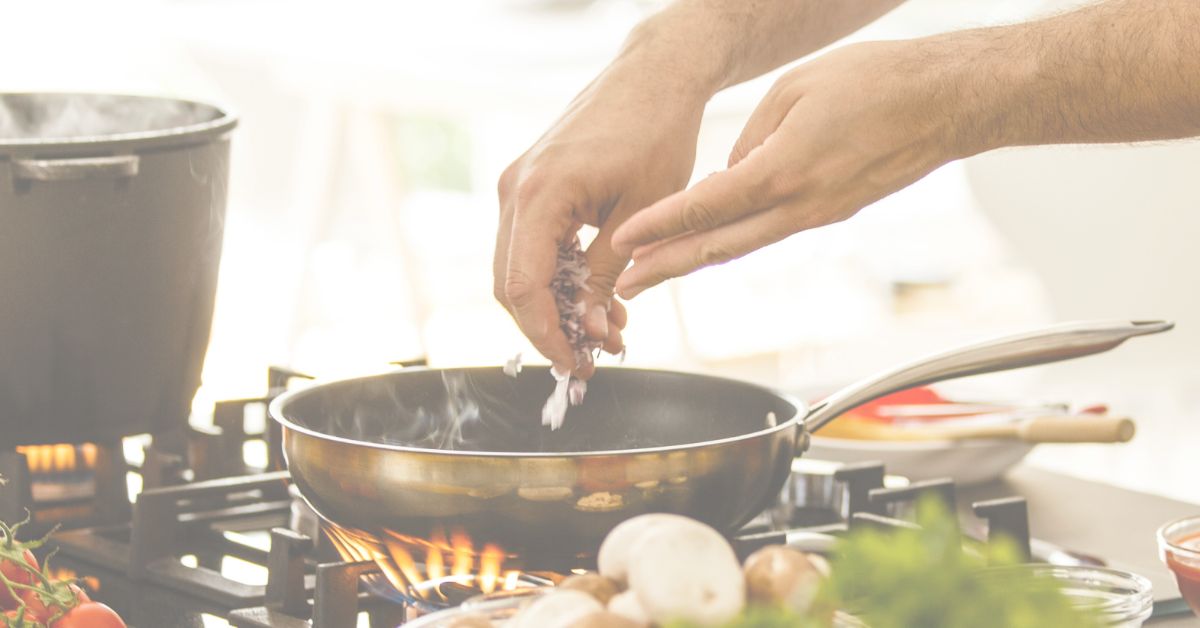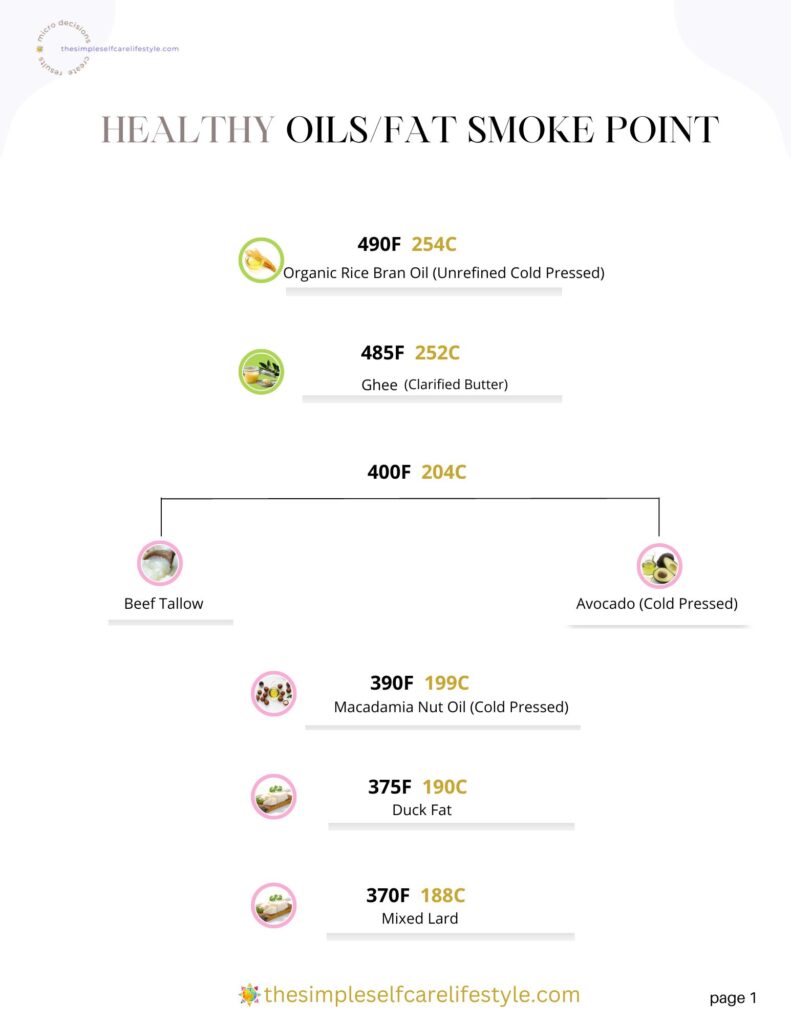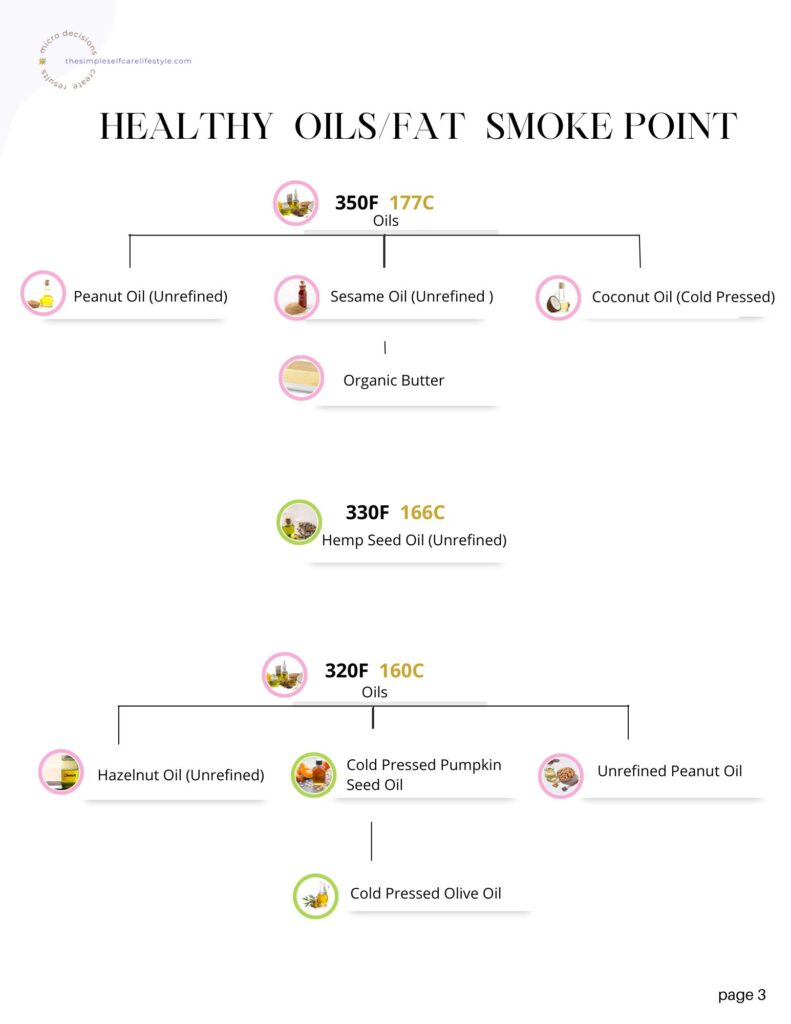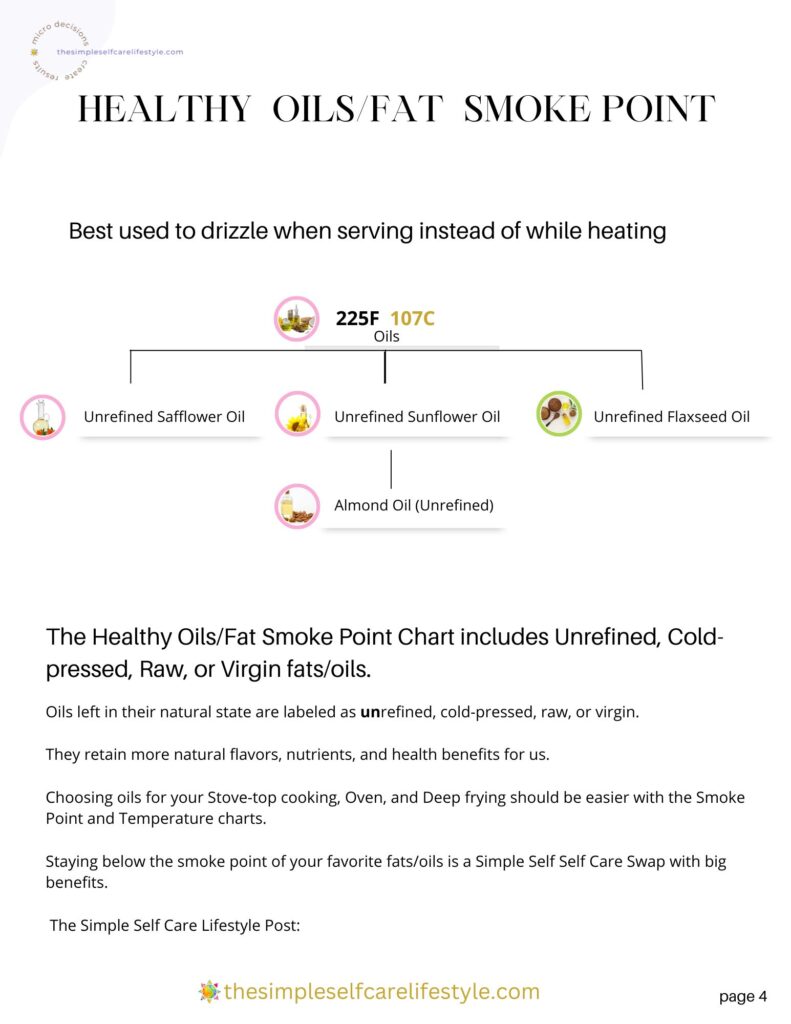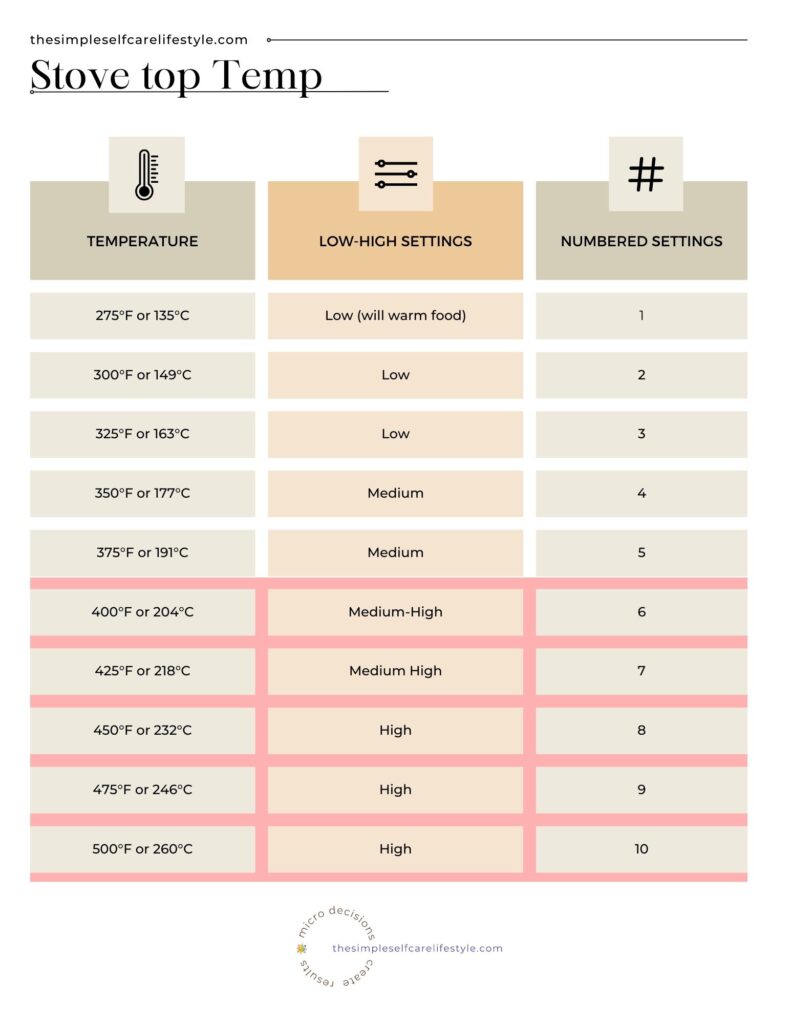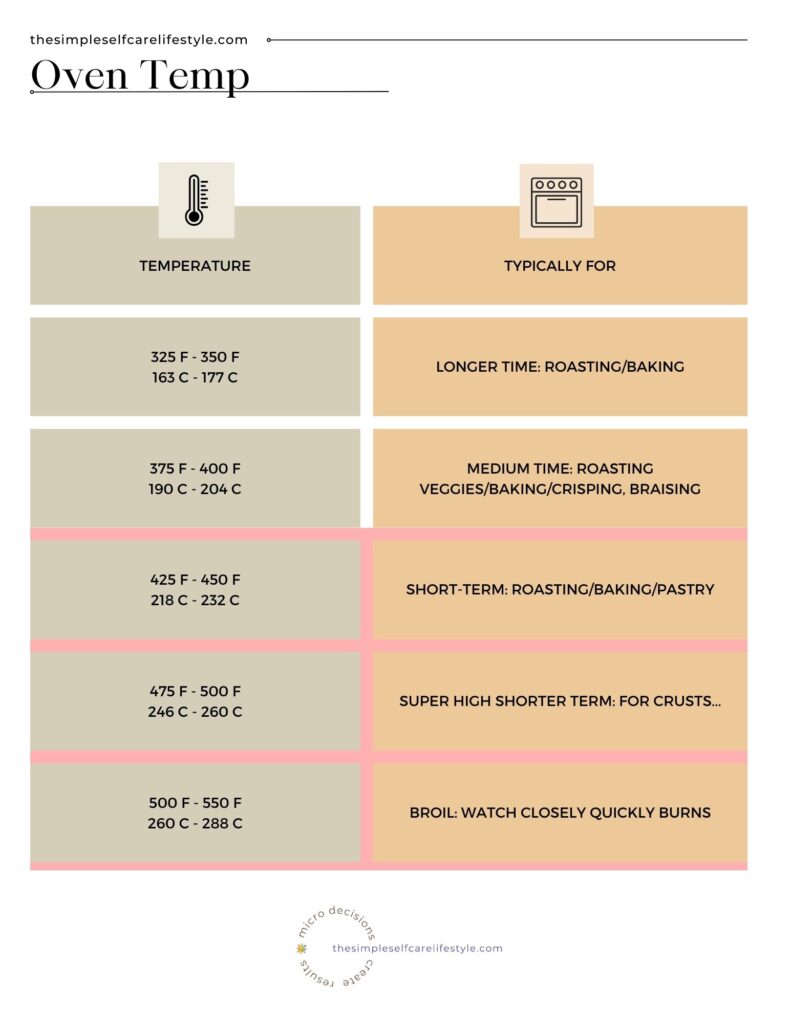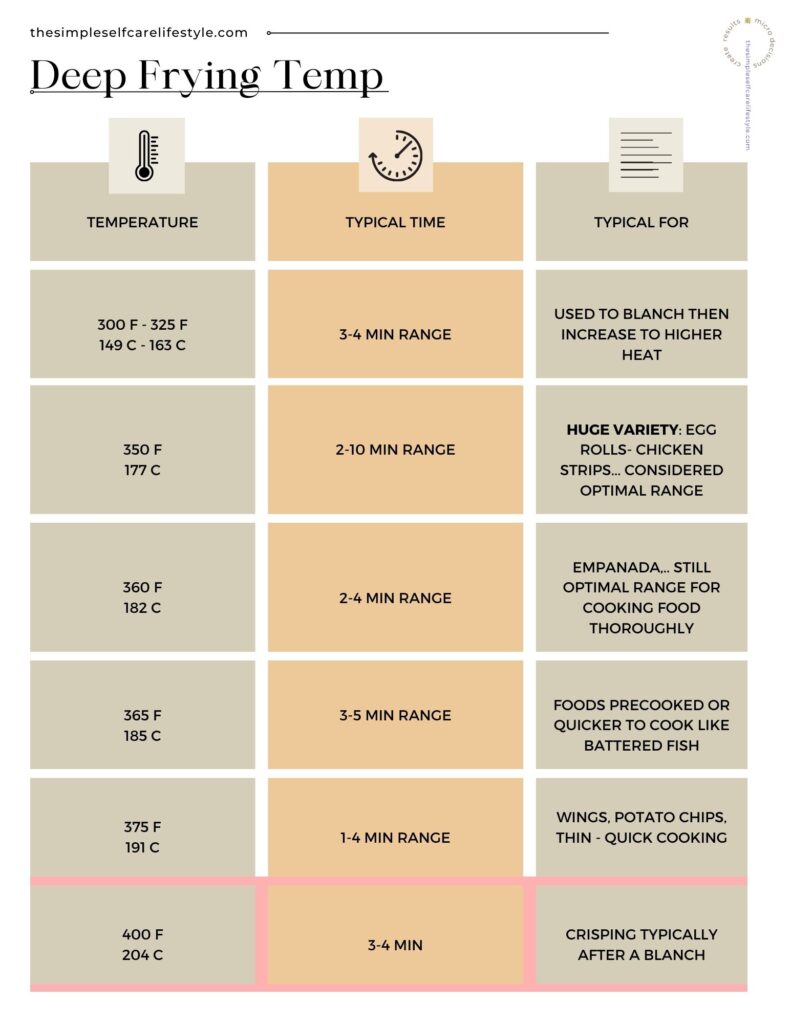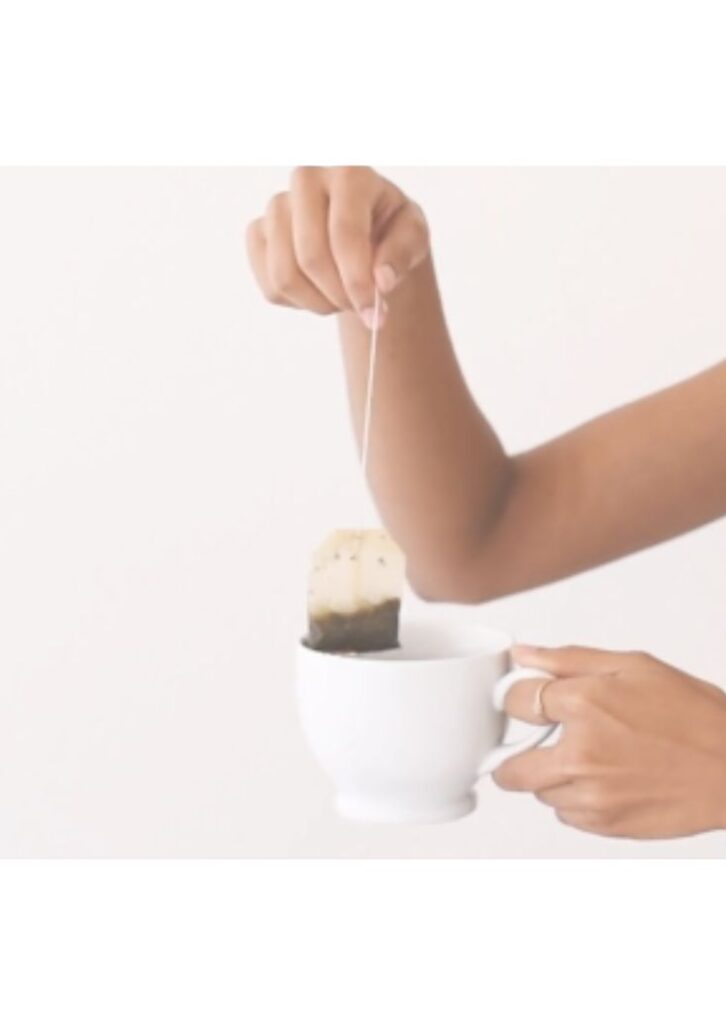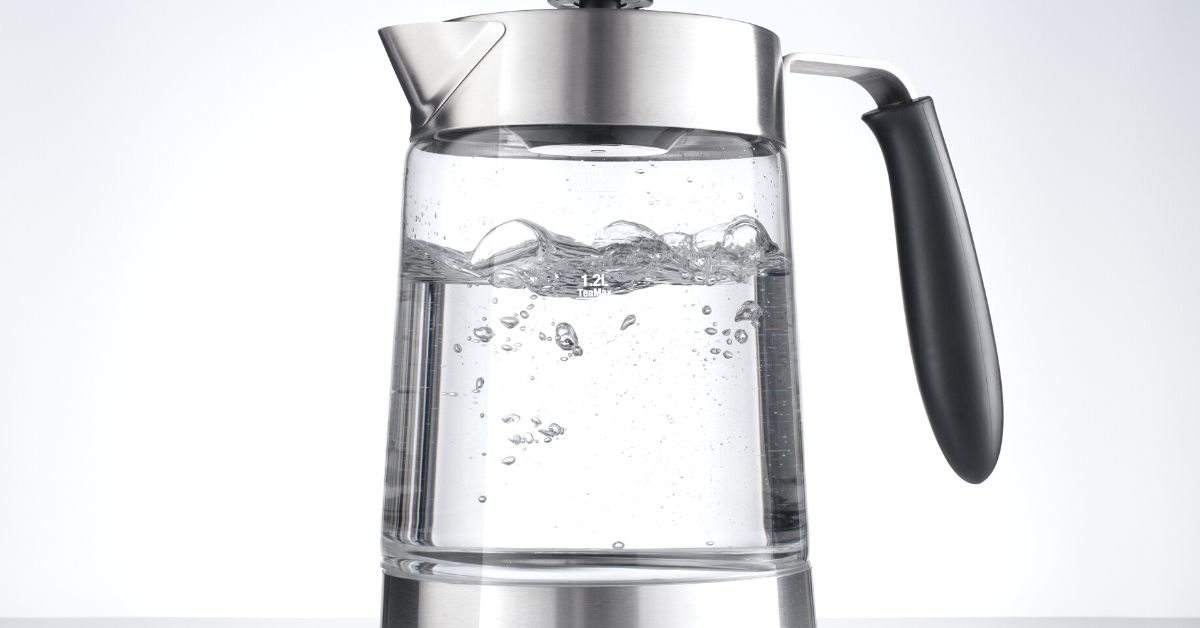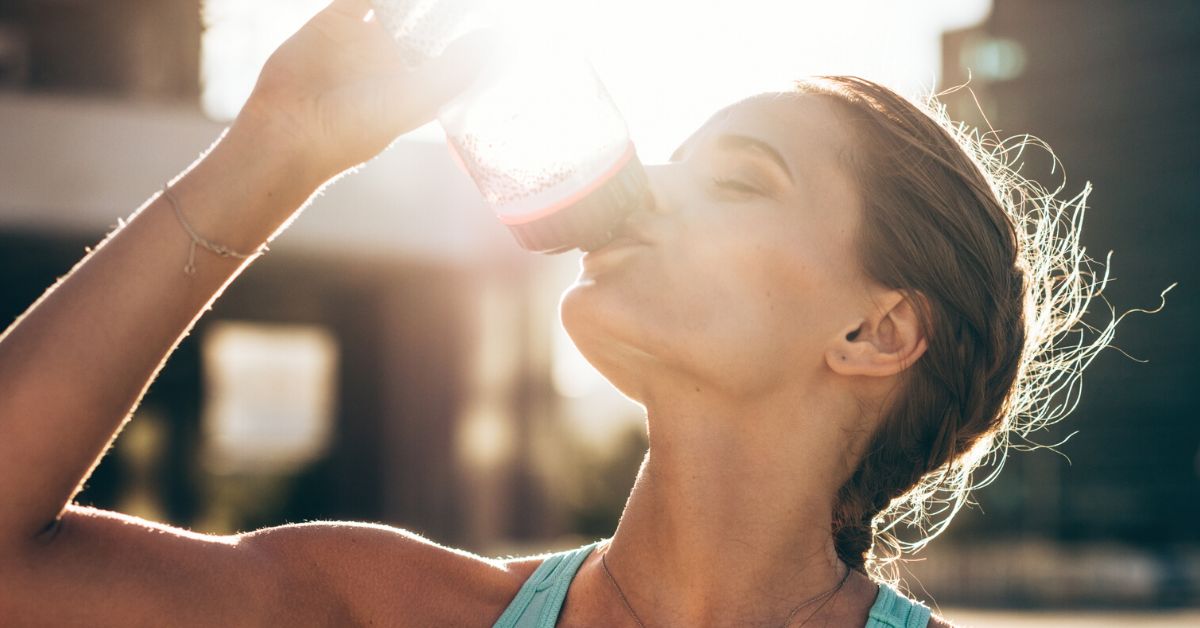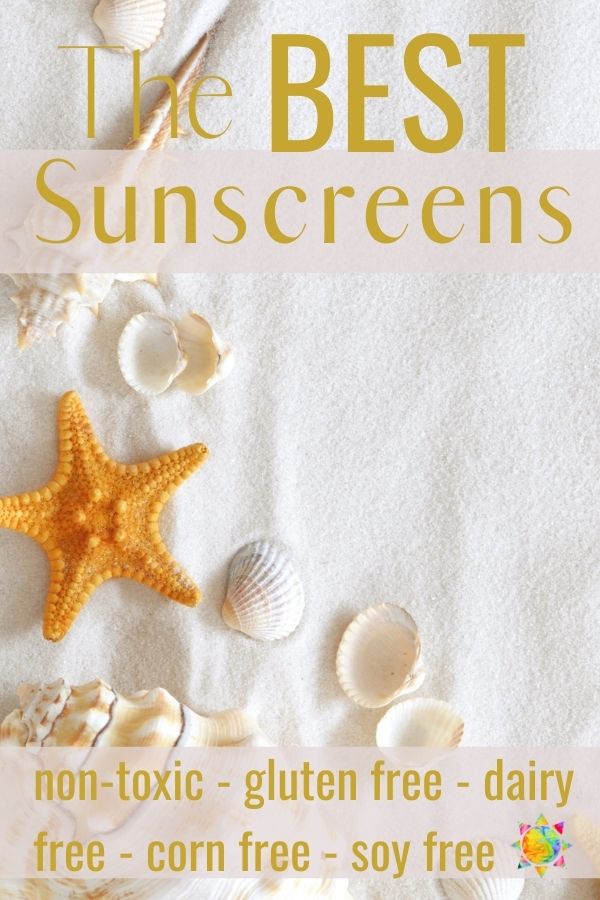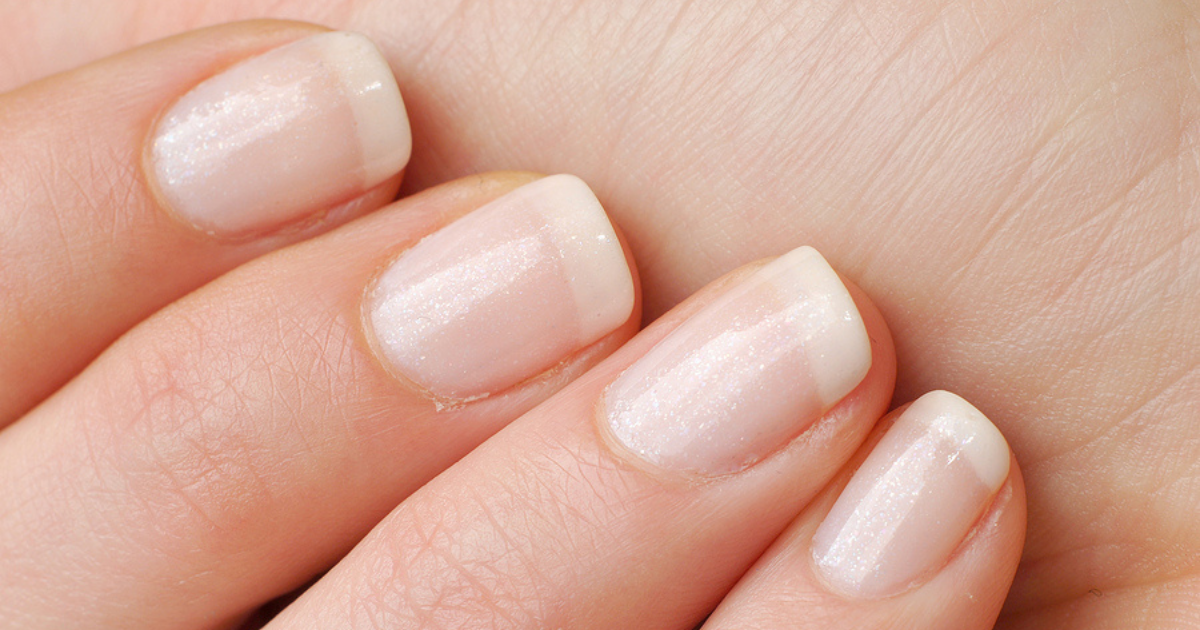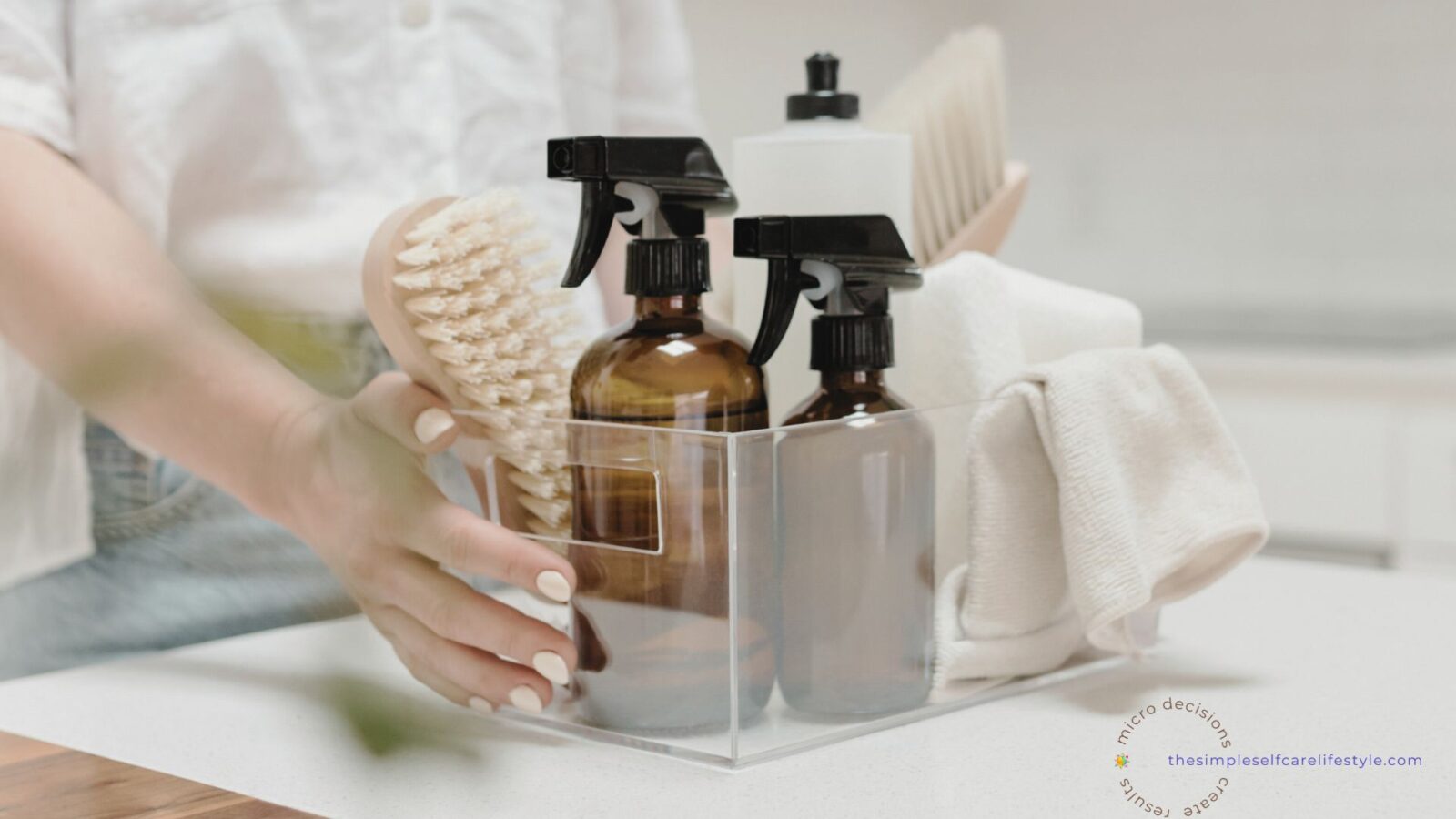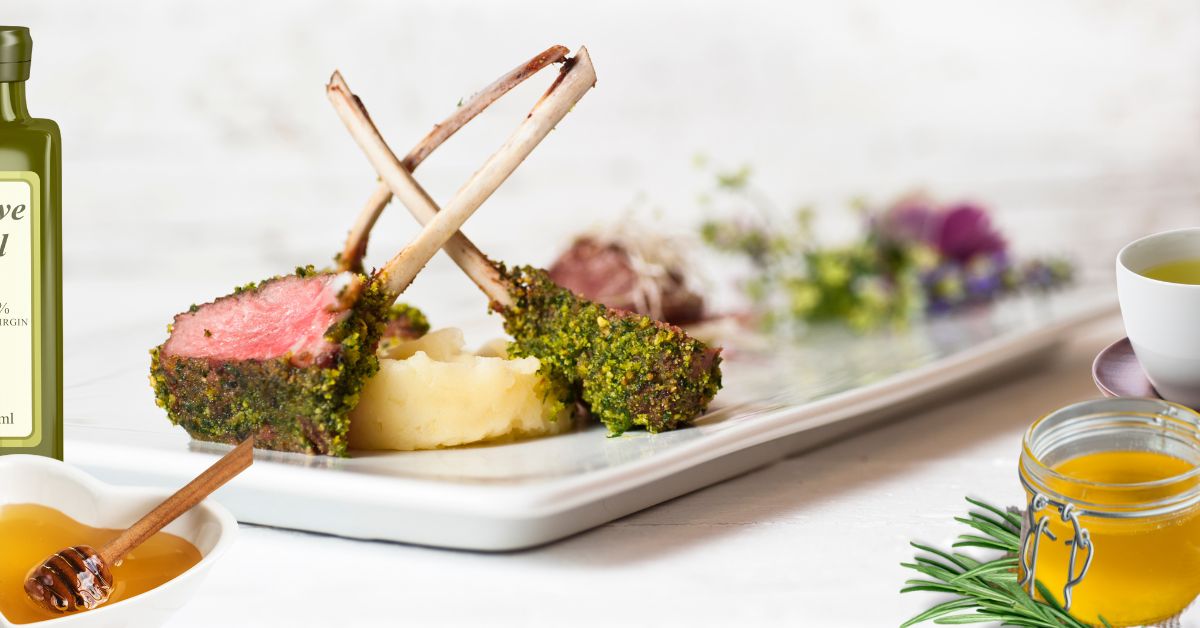Smoke Point For Coconut Oil Plus 19 Other Healthy Fats
The smoke point for cold-pressed, unrefined, raw coconut oil is 350 F (177 C). I’ve created a chart for you that includes the smoke point of coconut oil and 19 other unrefined, cold-pressed healthy oils/fats. There are buttons to download the PDFs at the end of today’s post.
What is a Smoke Point, and Why does it matter?
The smoke point refers to the temperature at which an oil breaks down and releases harmful compounds.
Today’s Simple Self Care Tip:
To reap the benefits of healthy fats and oils, use them below their smoke point.

This post is in response to an email I received:
“mo, I’m confused about the Smoke Point for Coconut Oil. Also I’m just not sure what fats/oils are healthy to use when it comes to my cooking on the stove top, baking or roasting in my oven, and deep frying. I bet others would like to know, too.
BTW, my fatty liver resolved following your worksheets.
And my hubby’s heartburn is gone after using the tips on your Indigestion posts. Thanks for being such a great resource.” Vivian L.
Q
Subscriber’s Q About Smoke Point of Healthy Oils
I’m confused about the Smoke Point for Coconut Oil. I’m just not sure what fats/oils are healthy to use when it comes to my cooking on the stove top, baking or roasting in my oven, and deep frying. I bet others would like to know, too…” Vivian L.
A
I Can Relate. I Found Choosing Fats Confusing In The Beginning, too.
Thank you for sending your question, Vivian. I appreciate your frustration because I also found choosing the right oil and fat to cook, bake, and deep fry confusing at first. So, I’m sure that you are right about others wondering how to figure it out, too.
It was a long time ago, but I do remember it took me months to figure out what to use when it came to my food prep.
I invested in and used healthy fats/oils only to turn them into degraded, even toxic, inflammation-provoking food that I consumed daily. Now, decades later, I can share that it was well worth the effort to learn how to choose and use healthy fats.
“Heat degrades polyunsaturated fatty acids to toxic compounds; saturated and monounsaturated fatty acids are resistant to heat-induced degradation.
Several types of diseases may be related to the exposure of humans to food- or even air-borne breakdown products of heated oils, including atherosclerosis, the forerunner to cardiovascular disease; inflammatory joint disease, including rheumatoid arthritis; pathogenic conditions of the digestive tract; mutagenicity and genotoxicity, properties that often signal carcinogenesis; and teratogenicity, the property of chemicals that leads to the development of birth defects and cancer.” (3)

To help make this Self Care Micro Decision SIMPLE for you to incorporate into your Self Care Lifestyle, I created downloadable charts for oils and fats, as I mentioned above, AND also Temperature charts for ovens, deep fryers, and stovetops.
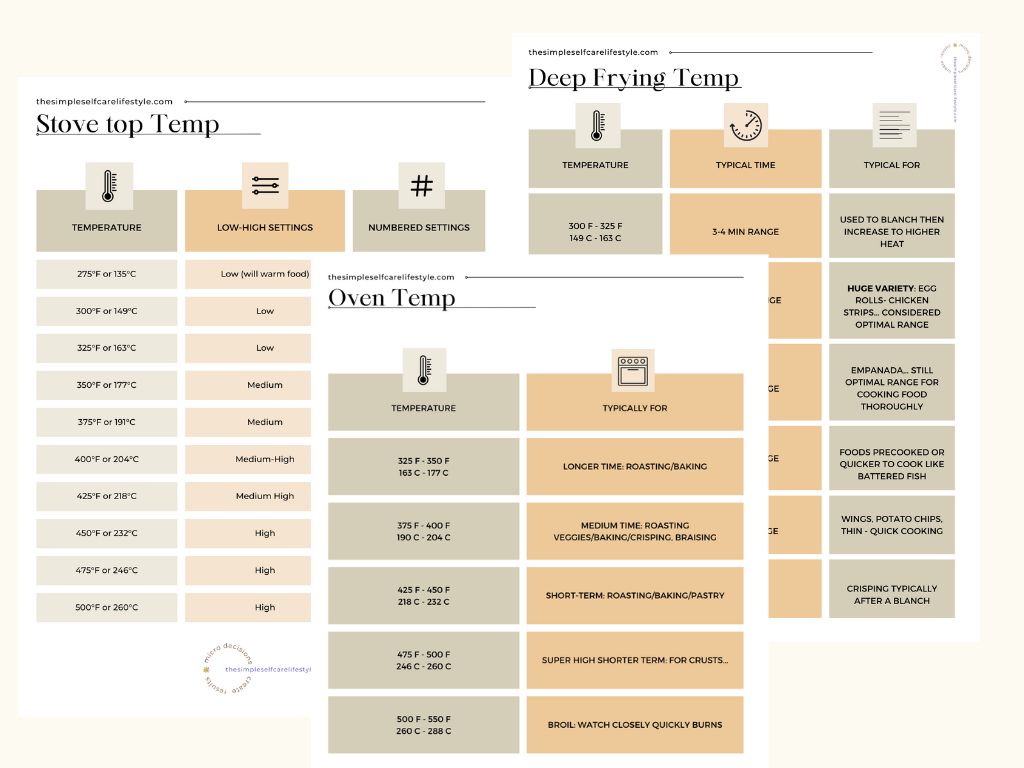
This is because if I only share the smoke point chart, it doesn’t give you any practical way to implement the Simple Self Care Action. Knowing only the smoke point isn’t very helpful if you do not know the temperature you are cooking at on your stove.
When I began shifting to choosing my cooking fats/oils by temperature, I realized I didn’t know the temperature I was cooking at on my stovetop because it was only labeled as Low, Medium, Medium-High, and High.
So, how could I know which oils/fats to use if I didn’t know the temperature I was cooking at? I couldn’t.
All the smoke point information I gathered was useless without knowing the temperature of each of my settings. I had to figure that out.
That was decades ago. My current stovetop is numbered 1-9, and then P. Since I know the temperatures for each, I’ve also included them on the charts.
All the charts are downloadable and located at the bottom of today’s post for you.
- The Oil/Fat Smoke Point Chart
- Stovetop Temp Chart
- Oven Temp Chart
- Fryer Temp Chart
Choosing the Healthy Fats on The Chart
I initially created a chart that included 50+ oils/fats, from the highest smoke point to the lowest. Then I went back and EXCLUDED Processed, Refined, and Ultra-refined.

What Makes Unprocessed, Unrefined, Raw Fats/Oil Healthier Options?
Oils left in their natural state are labeled as unrefined, cold-pressed, raw, or virgin.
The fats left in their natural state are healthier because they:
- retain their natural health-giving properties,
- are richer in nutrients and
- typically contain beneficial compounds like antioxidants and omega-3 fatty acids.
This is mainly because unprocessed fats, such as cold-pressed oils and unrefined, raw fats, are produced without filtering, bleaching, high heat, additives, preservatives or chemicals during extraction that research indicates are harmful to health.
You Benefit Right Down To Your Cells
Unprocessed, Unrefined, Raw Healthy Fats provide us with benefits right down to our cells. They are HUGE contributors to our 1 GOAL & 1 FOCUS.
This is because healthy fats are the foundation of our cell membranes.

Self-Care information, tips, tools, products & programs
That’s right the fats we eat make their way into our cell membranes. The cell membrane uses them for creating the Structure, Machinery, Instruction, Layers of protection and Energy of your cell.
Cell membranes are unequivocally the foundation of our cellular health. Our cell membranes need us to consume unadulterated fats that are balanced in saturated, monounsaturated, and polyunsaturated fats.
THe simple self care lifestyle
Simplify
Why Are Some Healthy Fats Able to Handle Higher Heat Than Others?
Factors that contribute to the stability of fat include the following:
- Type of fatty acids it contains (fats with higher levels of polyunsaturated fats are less stable when heated).
- Saturation level (the higher percent of saturated fat in a fat or oil is more stable than unsaturated fats)
- The presence of antioxidants in the particular oil/fat.
How to Use the Healthy Oil/Fat Smoke Point Chart
- Consider the temperature you would like to cook/bake/deep fry at.
- Choose your oil/fat according to the smoke point.
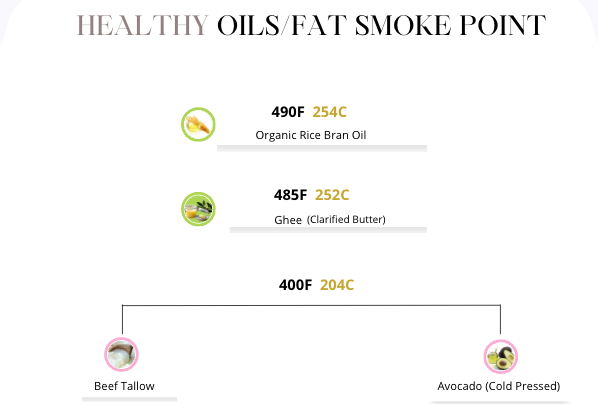
Please note that the information I researched and compiled on the multipage chart is provided as a general guideline. An oil’s smoke point varies depending on its quality, purity, and processing methods. If you want to dive deeper, it is always a good idea to refer to the product’s packaging and consult the manufacturer for accurate smoke point information. I do this any time I make a fat/oil brand change.
Which Fats Do I Use Most For Cooking, Baking, Deep Frying?
I’m often asked which I use for cooking, baking, frying, etc. —here’s my typical list. I’ve ordered oils/fat I use the most at the top.
Coconut oil:
Coconut oil: It is stable in high heat due to its high saturated fat content. Saturated fats are more resistant to heat-induced oxidation compared to unsaturated fats. Additionally, coconut oil contains a significant amount of medium-chain triglycerides (MCTs), which are highly stable and can withstand high temperatures without breaking down. These properties make coconut oil suitable for cooking methods involving high heat.
Duck Fat:
Duck fat: Its unique composition makes it suitable for high-heat cooking. It is primarily composed of saturated fats, which are more stable and have a higher smoke point than unsaturated fats. Additionally, duck fat contains a good balance of monounsaturated and polyunsaturated fats, contributing to its flavor and texture. The combination of saturated and unsaturated fats in duck fat provides stability and a rich, savory taste when used for high-heat cooking methods such as frying and roasting.
Ghee:
Clarified butter (ghee): Clarified butter, also known as ghee, is created by removing the milk solids from butter, resulting in a pure fat with a higher smoke point. Ghee has a high concentration of saturated fats, which are more resistant to heat-induced oxidation compared to unsaturated fats. This makes ghee a suitable choice for high-heat cooking methods.
Avocado Oil:
Avocado oil: When heated, its stability is attributed to its composition, which includes a high concentration of monounsaturated fats. Monounsaturated fats are known for their resistance to oxidation and degradation at high temperatures. Additionally, avocado oil contains a relatively low level of polyunsaturated fats, which are more prone to oxidation. These factors contribute to avocado oil’s ability to maintain its stability and high smoke point during cooking.
Rice Bran Oil:
Rice bran oil: Rice bran oil is suitable for high-heat cooking due to its high smoke point and stability. It contains a balanced composition of fatty acids, including monounsaturated, polyunsaturated, and saturated fats. However, what sets rice bran oil apart is its high content of antioxidants, such as vitamin E and oryzanol. These antioxidants help protect the oil from oxidation and degradation at high temperatures, making it suitable for various high-heat cooking methods such as frying, sautéing, and stir-frying. Additionally, rice bran oil has a mild flavor that doesn’t overpower the dishes, making it a versatile choice for different cuisines.
Beef Lard (Tallow):
Beef lard: Beef lard is good for high-heat cooking due to its high smoke point and stability. Like duck fat, beef lard is primarily composed of saturated fats, which are more resistant to heat-induced oxidation compared to unsaturated fats. The high saturated fat content in beef lard allows it to withstand high temperatures without breaking down, making it suitable for frying, roasting, and other high-heat cooking methods.
2 Notes:
- When it comes to cold dressings, etc., I use additional oils not listed here, each with specific health and wellness benefits. I will post about that for you later.
- Research indicates that some cold-pressed oils are not necessarily more vulnerable to high-heat cooking. These oils are not typically found in the mainstream markets, so including them would be misleading and confusing. But if you are an oil connoisseur with access to such oils, the seller can share their smoke point with you.
Simple Self Care Tool: Smoke Point & Appliance Temp Charts


Thanks so much for the fantastic question, Vivian! References are further below. Have a fantastic day!

Other posts that provide Self Care Tips, Tools & Simple Self Care Swaps you might like:

I’m glad you are here…
Self-Care information, tips, tools, products & programs
The Simple Self Care Lifestyle
When you find out how achieving the 1 GOAL of Optimzing Your Terrain makes every other health, wellness & fitness GOAL achievable- it SIMPLIFIES everything.
(MO)
THe simple self care lifestyle
Simplify
Post category
Common Conditions
Fatty Liver, Indigestion, Incontinence…
Post category
NUTRITION
Providing our Cells with what they need.
Post category
Healthy Home
Simple Swaps for Your Home
Post category
MOTION
Mobility, Exercise, Fitness
Post category
EMOTION
Mindset, Motivation, HPA Axis...
References for you:
Cooking Oils and Smoke Points: What to Know and How to Choose the Right Cooking Oil. Masterclass. Updated Sept 25, 2019.
Health effects of oxidized heated oils. Foodservice Research International. 2001;13(1):41-55.
Evaluation of chemical and physical changes in different commercial oils during heating. Acta Scientific Nutritional Health. 2018;2(6):2-11.
additional references
Replacement of Dietary Saturated Fat by PUFA-Rich Pumpkin Seed Oil Attenuates Non-Alcoholic Fatty Liver Disease and Atherosclerosis Development, with Additional Health Effects of Virgin over Refined Oil. PLoS One. 2015 Sep 25;10(9):e0139196. PMID: 26405765; PMCID: PMC4583328.
Cooking Oils and Smoke Points: What to Know and How to Choose the Right Cooking Oil. Masterclass. Updated Sept 25, 2019.
Source: © The Health Sciences Academy ®. https://thehealthsciencesacademy.org
more resources
Grootveld M, Silwood CJL, Addis P, Claxson A, Serra BB, Viana M. Health effects of oxidized heated oils. Foodservice Res Int. 2001;13(1):41-55.
de Alzaa F, Guillaume C, Ravetti L. Evaluation of chemical and physical changes in different commercial oils during heating. Acta Scientific Nutritional Health. 2018;2(6):2-11.
more resources
SMorrison MC, Mulder P, Stavro PM, Suárez M, Arola-Arnal A, van Duyvenvoorde W, Kooistra T, Wielinga PY, Kleemann R. Replacement of Dietary Saturated Fat by PUFA-Rich Pumpkin Seed Oil Attenuates Non-Alcoholic Fatty Liver Disease and Atherosclerosis Development, with Additional Health Effects of Virgin over Refined Oil. PLoS One. 2015 Sep 25;10(9):e0139196. doi: 10.1371/journal.pone.0139196. PMID: 26405765; PMCID: PMC4583328..
Quality Food Sources
Sources of High Quality: Ghee, Honey, Meats, Salts, Teas…

